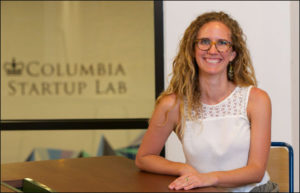
By: Karina Nagin ’11SIPA, Executive Director, Mission: Restore
In the summer of 2015 I attended the Penn-Columbia Social Impact House. The one-week fellowship brought together social entrepreneurs to “train and help optimize their purpose and impact for social good”. One entire day of the fellowship was dedicated to Design Thinking, facilitated by Gray Garmon.
Now, I have been a Human Centered Design groupie since Ideo.org launched its toolkit. And as a secret arts and craft junkie I love the design thinking process….post-it notes, brainstorming, colored markers, “yes and” mindset? Count me in! But this time I was more than a little skeptical. I had recently become the Executive Director of a global health non-profit and had been given the task of rethinking our approach to surgical training. I loved arts and craft time, but I needed to figure out how to improve the capacity of surgeons in developing countries. I was thinking about skills that involved scalpels, not colored markers.

So when I was chosen to be one of the organizations to workshop a challenge using design thinking, I was skeptical. Sure, post-it notes are fun, but I had real problems. How do you improve access for the 5 billion patients who lack quality surgical care globally? How do you train and support surgeons who are working in some of the toughest regions and are overworked and under resourced? How could I do this on a shoestring non-profit budget? So yes, I was hesitant picking up my marker and approaching the white board.
But as soon as we started I got caught up in the excitement of my group. I had five amazing entrepreneurs who were giving me their full attention and excited to help me think outside the box. After framing my challenge question and a whirlwind brainstorm, the first post it was stuck up on the wall.
“What if we create a regional dream team of surgeons? What would that entail?” The ideas snowballed from there.
When the wall was filled with yellow squares, we did a rapid prototype of our new approach to surgical training. This involved a cardboard mockup of google glass, construction paper training certificates, fake blood, a plastic spoon for a scalpel, toilet paper bandages and yes, Post-it notes.
Some of the ideas were a little crazy, but what came out of that brainstorm was the seed of a new idea…a “regional training model” that would help connect surgeons, often working in isolation, and allow them to share, learn and support each other.
I took the energy and enthusiasm from that design session back to my team and got to work. Four months later to the day, we piloted the training model that came out of that design session with our partners in Mwanza, Tanzania. The one-day training included doctors from every district hospital in the region. 17 participants, and the results were good…really good in fact. We didn’t stop there. We collected surveys, conducted follow up interviews, listened to participants’ feedback, and iterated the model to take it to the next level.
The result: This past June Mission: Restore hosted our inaugural 3 day East Africa Regional Training Conference in Reconstructive Surgery at the University of Nairobi. We hosted 41 young surgeons from across 9 countries (including Congo-Brazzaville, Burundi, Tanzania and Uganda). Over 25% of our participants were women and many were the only surgeon working in their region.
The training was such a huge success that we’re making it an annual event and bringing that same model to other hospitals in the region. As we begin to plan our 2nd Annual East Africa Surgical Training, I’m in awe remembering how it started, with a marker in my hand and great group coming together to tackle a challenge. That’s the beauty of the design thinking process: it requires an open mind, a supportive group, rapid prototyping, and a stellar team. My team was able to use this process to redesign programs on their feet listening to feedback from our participants. This experience was a much needed reminder that your problems are never too big to tackle with Design Thinking, colored markers and of course, a few post-its.

